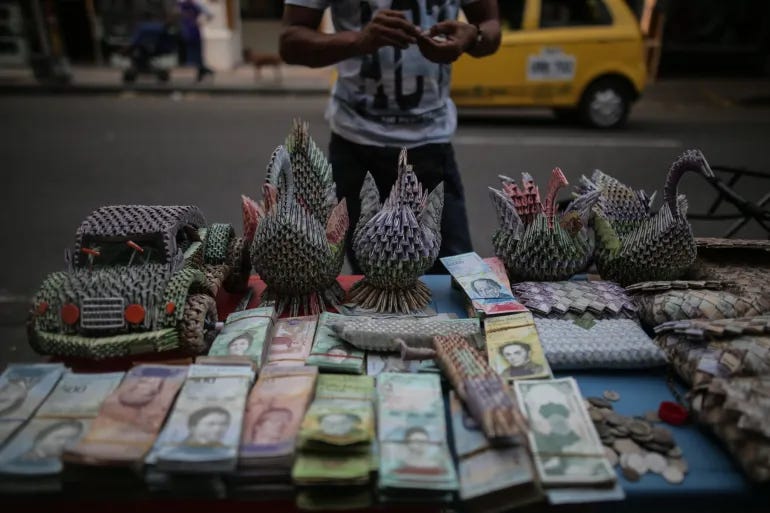The Unofficial Dollar: How USDT Became the Currency of the Developing World
In much of the world, the U.S. dollar is a lifeline. But while “developed” economies debate stablecoin regulation, emerging markets have already made their decision. For millions of people, USDT is their dollar.
Tether’s presence in the developing world has grown far beyond crypto trading. It has become a key part of daily transactions, remittances, savings, and even unofficial foreign reserves in nations struggling with currency instability and capital controls. The shift isn’t theoretical as it’s happening on the ground, and it’s redefining global finance. For sources, feel free to check out my earlier articles!
Why Emerging Markets Rely on USDT
Gabor Gurbacs, a strategist at Tether, recently highlighted an older article of his about seven ways USDT is transforming emerging economies. Super interesting insights that offer a foundation for understanding why stablecoins, particularly USDT, have embedded themselves so deeply in financial systems across Latin America, Africa, and parts of Asia.
Rather than simply repeating those points, let’s take them further. It goes without saying that the impact of Tether extends beyond financial inclusion. Let’s take a closer look at how it is most likely redefining monetary sovereignty, financial policy, and even geopolitical power structures.
Why USDT is a Safe Haven
For citizens of countries facing hyperinflation, USDT provides the ability to preserve wealth in ways their national currencies cannot.
Argentina: With annual inflation surpassing 250%, holding pesos means losing money. Many Argentinians use USDT as a store of value and medium of exchange. More in-depth reading on the actual inflation below!
Turkey: The lira has lost more than 80% of its value in the last five years. USDT allows Turkish businesses and individuals to hold dollars without relying on a fragile banking system. Huge CEX market too…..
Lebanon: Following a banking collapse (ever since 2019), Lebanese citizens turned to USDT as their only reliable financial option when banks froze dollar withdrawals
Unlike official dollarization, which requires government approval, USDT adoption happens at the grassroots level; without central banks needing to sign off (yet)
Is USDT Becoming an Alternative Reserve Asset?
Some governments may not officially acknowledge USDT holdings, but there is speculation that certain central banks, sovereign wealth funds, and financial institutions hold USDT in unofficial reserves. Some wild speculation but not unimaginable.
For countries facing U.S. sanctions or financial restrictions, USDT offers a way to bypass traditional banking rails. It allows institutions to hold dollar-equivalent reserves without reliance on the Western financial system. And it allows citizens of sanctioned countries to go about their daily business. It isn’t until you speak to someone who has been cut off from all financial rails and everyday platforms that you truly understand how impactful this can be.
Cross-Border Payments Without the Middlemen
Sending money across borders has historically been expensive, with companies like Western Union charging up to 10% in fees. USDT removes the need for intermediaries.
Nigeria: Businesses importing goods use USDT because local banks impose capital controls that restrict access to dollars
Venezuela: With its banking sector crippled by hyperinflation, remittances in USDT provide a stable and very empowering financial lifeline to millions
Afghanistan: Following the Taliban’s takeover, many Afghans relied on USDT for cross-border transactions after the country was cut off from SWIFT
USDT allows people to send and receive value instantly, across borders, with little friction.
Banking Without Banks: How USDT Expands Access
In many developing countries, the biggest obstacle to financial participation isn’t a lack of money; it’s a lack of access to stable money. Over 1.4 billion adults worldwide lack a bank account, but most of them have a mobile phone. USDT allows them to transact without needing a traditional bank.
Bringing Stability for Investors in Volatile Markets
For developing nations, currency volatility discourages investment. If investors cannot trust the value of their returns, they will hesitate to allocate capital.
By enabling transactions in stable digital dollars, USDT removes the currency risk that has traditionally kept foreign investors away.
Cheaper, Faster Transactions in an Unstable World
Traditional banking fees in many developing nations are prohibitive. USDT allows for near-instant transfers with fees that are a fraction of the cost of legacy financial systems.
A Digital Economy Without Borders
While central banks discuss launching CBDCs, Tether is already filling that role. Instead of waiting for government-led digital dollar projects, markets are organically choosing USDT as their unofficial CBDC.
The widespread adoption of USDT in emerging markets raises questions that go beyond Web3. Stablecoins are decoupling from crypto markets and will continue to do so, raising new questions;
Does this challenge the role of central banks in weak economies? If people opt out of local currencies and only transact in USDT, does the government lose control over monetary policy?
Will the U.S. government react? The irony is that USDT is actually helping to sustain dollar dominance globally, yet it remains outside direct U.S. regulatory oversight
Could we see a geopolitical battle over stablecoins? If a foreign power wanted to weaken U.S. influence, restricting USDT adoption could be a strategy. Conversely, Tether’s role could strengthen the dollar’s grip in a way that traditional banking cannot
Stablecoins have often been discussed in the context of crypto markets, but the reality is much bigger. For millions of people USDT is a financial necessity. In a glib way, it’s the “people’s coin.” It provides stability, access, and freedom in places where the traditional system has failed and is potentially actively defrauding its citizens, whether through bank freezes or controlled hyperinflation.
I love stablecoins, Tether in particular, and I will be writing about the ongoing and ever-increasing future stablecoin war. Stay tuned for insights, drama, and analysis as it all unfolds.
P.S. In case you didn’t realize, I am not Patrick Hansen



